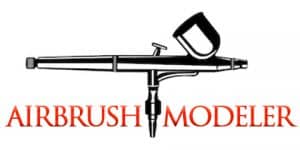When I was searching for my very first airbrush compressor many years ago I got quite lost on all of the different options available, I simply didn’t really know what I needed.
When trying to determine the right sized compressor for me I was greeted with many questions, such as: how much power will I need, how much air pressure, single piston or multi-piston, and what do these things weigh…?
After a lot of research I learnt the following about what size compressor I needed for airbrushing…
The ideal compressor size for general airbrushing is a single-piston unit with at least 1/8 horsepower and a compressed air tank capable of holding at least two litres of air and producing at least 30 psi air pressure, with the unit typically weighing in at approximately 10-12 pounds.
In terms of measuring the ‘size’ of an airbrush compressor I realised that there were a number of compressor characteristics that would be used to broadly assess the size and capability of the compressor that was perfect for me.
These characteristics are:
- Compressor motor horsepower
- Number of pistons in the motor
- With tank or without tank
- Maximum air pressure generated
- Overall weight and dimensions of the compressor
So that you can choose the compressor that’s perfect for you, let’s look in detail at why these particular characteristics matter…
How Much Horsepower Should An Airbrush Compressor Have
An airbrush compressor should have at least 1/8 horsepower so that it is capable of delivering a sufficient pressure and volume of air to your airbrush.
More horsepower means more air pressure and volume of air being pumped through the air hose to your airbrush.
If you’re using an airbrush that has a very fine nozzle for detail painting you only need a small amount of air pressure, however if you’re going to be using up to 0.5mm nozzles which are quite common then you’ll be best served by having a more powerful airbrush compressor of 1/6 horsepower or greater.
The last thing you want is to need a certain amount of air pressure to properly complete your paintwork to the highest standard you can possibly do, only to be hamstrung by the fact that you don’t have a compressor with sufficient power.
The following table gives you an approximate guide of what power ratings give what air pressure:
(different power ratings will give slightly different air pressures depending on the brand and quality of the compressor)
| Pressure Output Category | Approximate psi | Horsepower | Example Compressor |
| Low | 1 – 20 psi | 1/12 | Iwata Ninja Jet |
| Low To Medium | 1 – 40 psi | 1/8 | Iwata Smart Jet |
| Low To High | 1 – 60 psi | 1/6 | Iwata Power Jet Lite |
I’ve personally used an Iwata Smart Jet for almost two decades for model building and artistic work and the power output and resulting air pressure have been more than enough to handle my every airbrushing need.
One thing I have noticed however is that sometimes the perfect pressure for my airbrushing, depending on the paint type, has been in excess of 20 psi which can be quite limiting if you have a low power air compressor.
So it’s always best to play it safe and opt for a compressor that will not be limiting, ensuring it has the ability to provide at least 30 psi.
I’ve noticed that I’ve never had to go above 30 psi to get best airbrushing results, so for me 30 psi makes a great starting point for narrowing down what compressor you want to buy.
RELATED: What To Look For When Choosing The Best Airbrush Compressor
How Many Pistons Should An Airbrush Compressor Have
An airbrush compressor with one piston will perfectly suffice for almost all airbrushing applications, however if you wish to run very high pressures or have multiple airbrushes going at once then a multi-piston setup will be required.
The majority of airbrush compressors sold today are single-piston units which will easily provide enough air pressure to handle all types of airbrush paint for virtually any creative application.
Single-piston airbrush compressors are capable of producing up to 60 psi so for this reason alone it’s often the first choice by default.
However if you find that you need an additional boost of power for running a mini spraygun or dual airbrushes then a single-piston unit simply won’t do it and you’ll have to opt for a dual-piston unit.
See below for examples of dual-piston (or more) units:
Compressor Brand & Type | Number Of Pistons | Air Tank | Max Air Pressure (psi) | |
Paasche DA400R | 2 | Yes | 50 | |
For reviews and current prices on the Paasche D400R see the Amazon listing here | ||||
Master Airbrush TC-848 | 2 | Yes | 57 | |
For reviews and current prices on the Master Airbrush TC-848 see the Amazon listing here | ||||
Is An Airbrush Compressor Better With A Tank
An airbrush compressor with a tank is better in that it will give you a more convenient and quieter operation that also totally eliminates pulsating air reaching your airbrush, however the technology in tankless air compressors is such that this pulsating is barely noticeable and shouldn’t overly impact your airbrushing.
My go-to compressor for airbrushing has no tank, and I’ve been happy with this unit for over twenty years, however before we focus on that lets first of all consider how a compressor with a tank is advantageous.
Having a tank on an airbrush compressor can significantly increase the overall size of the unit, so it space savings are important to you when choosing which compressor to buy it may be worthwhile to opt for a tankless air compressor.
If the largest of the tankless compressors are around two standard shoeboxes high, then adding a tank to the compressor will essentially be the equivalent of adding another shoebox to the top.
Below are some examples of compressors which come with a tank and the overall dimensions:
Compressor Brand & Type | Dimensions (mm) W x H x L | Dimensions (in) W x H x L | |
Iwata Power Jet Pro | 177 x 330 x 313mm | 7.0 x 13.0 x 12.4in | |
For reviews and current prices on the Iwata Power Jet Pro see the Amazon listing here | |||
Badger Aspire Pro TC910 | 140 x 360 x 330mm | 5.5 x 14.2 x 13in | |
For reviews and current prices on the Badger Aspire Pro TC910 see the Amazon listing here | |||
Sparmax TC-620X | 180 x 345 x 330mm | 7.1 x 13.6 x 13.0in | |
For reviews and current prices on the Sparmax TC-620X see the Amazon listing here | |||
But let’s not forget that I use a compressor without a tank, why do I do that if it’s not as good…?
Ultimately I use a compressor with a tank because my unit is quiet enough already, I do not get pulsating air through my lines, and my overall paint finish quality is extremely high with the equipment I have.
For me it’s not worth chasing a possible small increase in the quality of the paintwork when I’m so happy with it already.
The image below is of an in-progress model I built and airbrushed which won me a State level competition, using my trusty Iwata Smart Jet Pro compressor that doesn’t have a tank – as you can see the gloss black came out so good it looks almost perfectly mirrored!
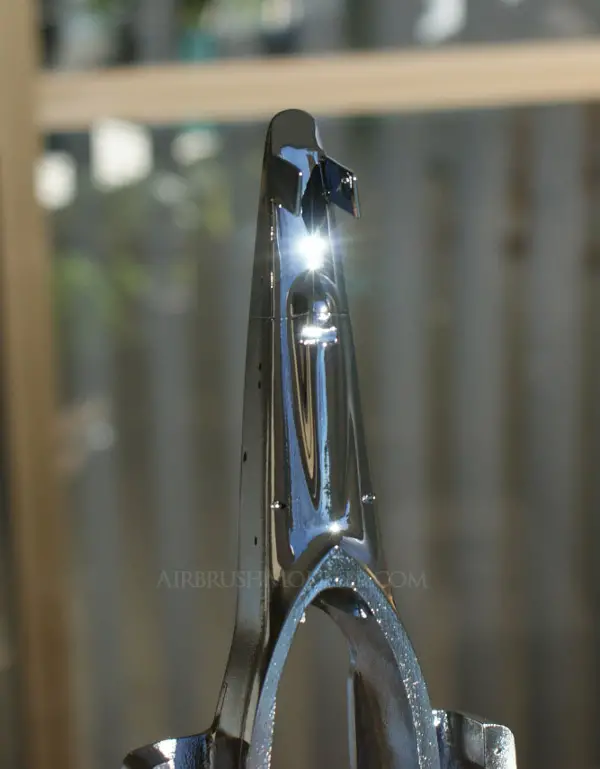
RELATED: Does An Airbrush Compressor Need A Tank
How Much Air Pressure Should An Airbrush Compressor Deliver
An airbrush compressor should be capable of delivering at least 30 psi to your airbrush for the broadest range of excellent airbrushing results regardless of the type of paint or airbrushing medium used.
When using a larger nozzle size and/or somewhat thicker paint you’ll need a reasonable amount of pressure from your airbrush compressor to get best results, and I’ve found that 30 psi has always been the most I’ve ever needed for painting model kits and basic artwork.
If, however, you know that you’ll be using comparatively very thick paint, for painting fabric for example, then higher pressures ‘may’ be required.
If this is the case then check with the manufacturer of the paint you’ll be using to get the air brushing pressure specifications and ensure you get a compressor that meets your need.
RELATED: Airbrush Air Pressure, What Pressure Should I Airbrush At For Perfect Results (Action Plan!)
What Weight And Dimensions Should An Airbrush Compressor Have
The perfect weight for an airbrush compressor is between 10 and 12 pounds so that it is easily moved or transported wherever you need it to go. Its dimensions should be roughly equal to the size of a standard shoe box to two standard shoe boxes (double height).
While I never really had a need to take my compressor anywhere other than my work bench, I did find that I was often repositioning my compressor depending on the job I was doing and the available light sources around the work area.
So while portability wasn’t high on my list of airbrush compressor requirements it was still extremely handy to have one that was fairly compact and not too heavy, if for no other reason than to move it for storing under my workbench when not in use.
Given the range of compressors on the market today and the most common weights within that range, a weight bracket of 10 to 12 pounds (~5 to 6 kgs) is optimal and quite within the ability of the average person to move around.
In fact many of these compressors come with carry handles for just this reason.
The size of the compressor also comes into play here depending on what your requirements are for storage and/or transport.
Most of the most popular compressor models on the market today are approximately the size of a standard shoebox on the small side and two shoeboxes stacked on top of each other on the larger side.
Sure you can get smaller sized airbrush compressors but when you then run the risk of limiting yourself to a unit that doesn’t provide enough air pressure.
It’s not so much a matter of getting the biggest compressor you can afford, it’s more about knowing what space you have for using and storing the compressor and then shopping for one that doesn’t exceed the space you know you have.
So now let’s look at what are considered to be the best sized airbrushes on the market for the broadest range of airbrushing tasks, which won’t break the bank…
What Is The Perfect Size Compressor For Airbrushing
The following are the best sized airbrush compressors to satisfy a broad range of airbrushing applications (both with and without a tank):
- Iwata Smart Jet Pro (w/o tank)
- Paasche D500SR (w/o tank)
- Badger TC908 (w/o tank)
- Master Airbrush TC-40T (w/ tank)
- Paasche D3000R (w/ tank)
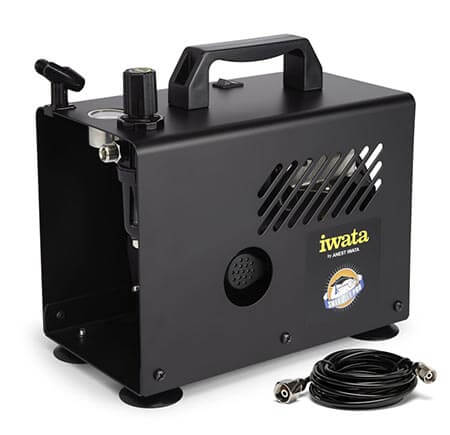
Iwata Smart Jet Pro
Pistons: 1
Horsepower: 1/8
Tank: No
Max Pressure: 30 psi
Weight: 11.84 lbs
Click here for current price and reviews of the Iwata Smart Jet Pro
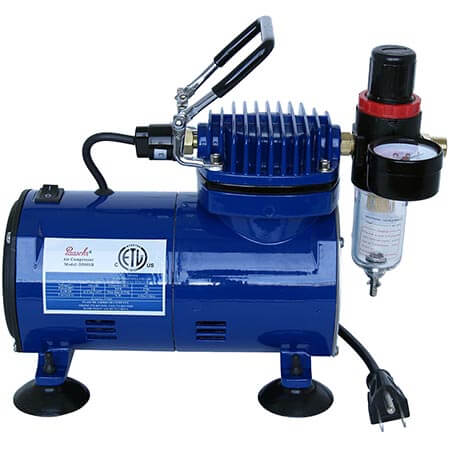
Paasche D500SR
Pistons: 1
Horsepower: 1/5 HP
Tank: No
Max Pressure: 30 psi
Weight: 8.3 lbs
Click here for current price and reviews of the Paasche D500R
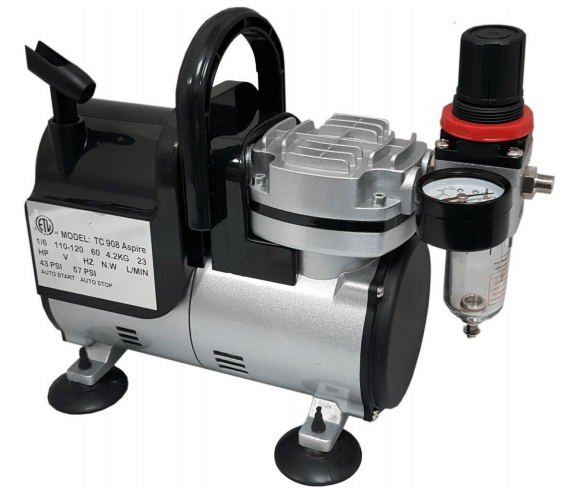
Badger TC908
Pistons: 1
Horsepower: 1/6 HP
Tank: No
Max Pressure: 30 psi
Weight: 7.9 lbs
Click here for current price and reviews of the Badger TC908
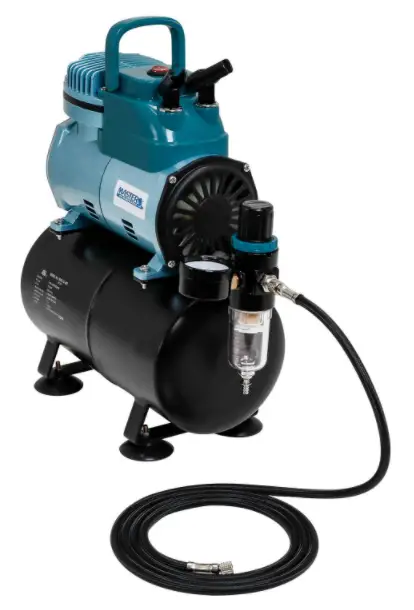
Master Airbrush TC-40T
Pistons: 1
Horsepower: 1/6 HP
Tank: Yes
Max Pressure: 30 psi
Weight: 11.5 lbs
Click here for current price and reviews of the Master Airbrush TC-40T
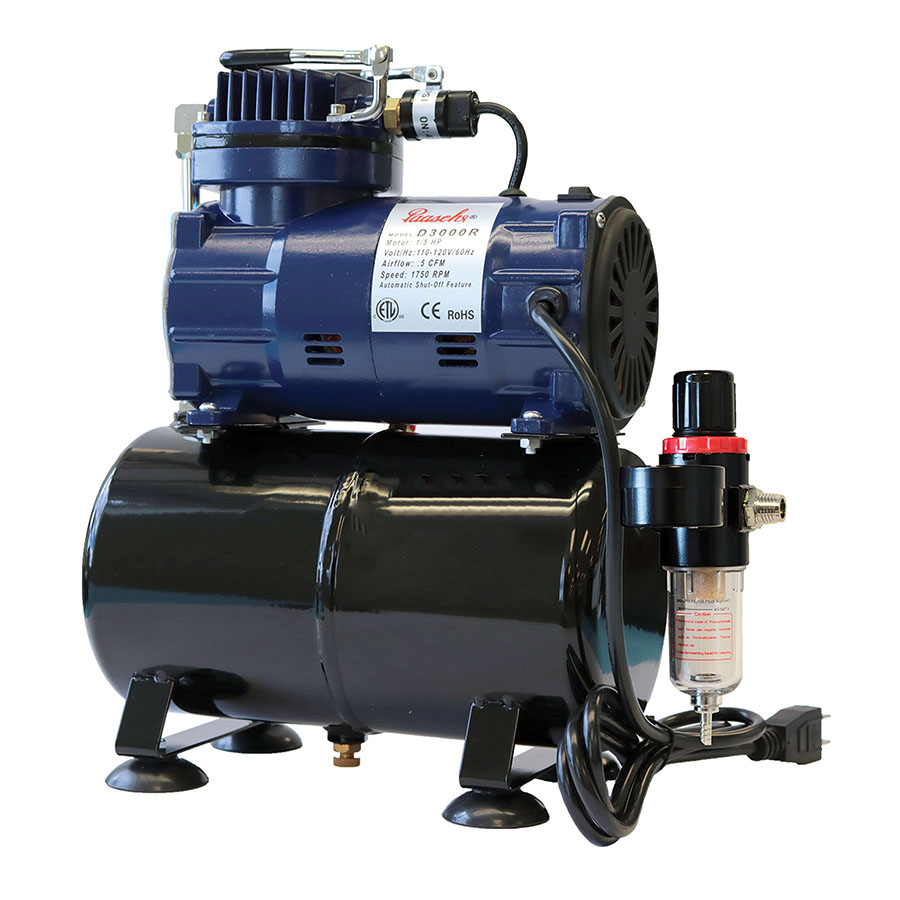
Paasche D3000R
Pistons: 1
Horsepower: 1/5 HP
Tank: Yes
Max Pressure: 30 psi
Weight: 11.1 lbs
Click here for current price and reviews of the Paasche D3000R
RELATED: What To Look For When Choosing The Best Airbrush Compressor
